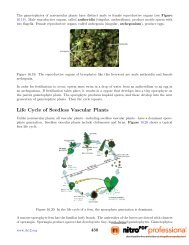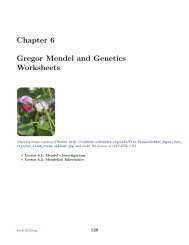Chapter 23 The Circulatory, Respiratory, Digestive, and Excretory ...
Chapter 23 The Circulatory, Respiratory, Digestive, and Excretory ...
Chapter 23 The Circulatory, Respiratory, Digestive, and Excretory ...
You also want an ePaper? Increase the reach of your titles
YUMPU automatically turns print PDFs into web optimized ePapers that Google loves.
Figure <strong>23</strong>.14: Alveoli are tiny sacs in the lungs where gas exchange takes place.<br />
dioxide is produced by cells as a byproduct of cellular respiration, so it is more concentrated in the cells<br />
than in the blood of the peripheral capillaries. As a result, carbon dioxide diffuses in the opposite direction.<br />
Back to the Lungs<br />
<strong>The</strong> carbon dioxide from body cells travels in the blood from the peripheral capillaries to veins <strong>and</strong> then<br />
to the heart. <strong>The</strong> heart pumps the blood to the lungs, where the carbon dioxide diffuses into the alveoli.<br />
<strong>The</strong>n, the carbon dioxide passes out of the body through the other structures of the respiratory system,<br />
bringing the process of respiration full circle.<br />
Gas Exchange <strong>and</strong> Homeostasis<br />
Gas exchange is needed to provide cells with the oxygen they need for cellular respiration. Cells cannot<br />
survive for long without oxygen. Gas exchange is also needed to carry away carbon dioxide waste. Some<br />
of the carbon dioxide in the blood dissolves to form carbonic acid, which keeps blood pH within a normal<br />
range.<br />
Blood pH may become unbalanced if the rate of breathing is too fast or too slow. When breathing is too<br />
fast, blood contains too little carbon dioxide <strong>and</strong> becomes too basic. When breathing is too slow, blood<br />
contains too much carbon dioxide <strong>and</strong> becomes too acidic. Clearly, to maintain proper blood pH, the rate<br />
of breathing must be regulated.<br />
Regulation of Breathing<br />
To underst<strong>and</strong> how breathing is regulated, you first need to underst<strong>and</strong> how breathing occurs.<br />
701 www.ck12.org





